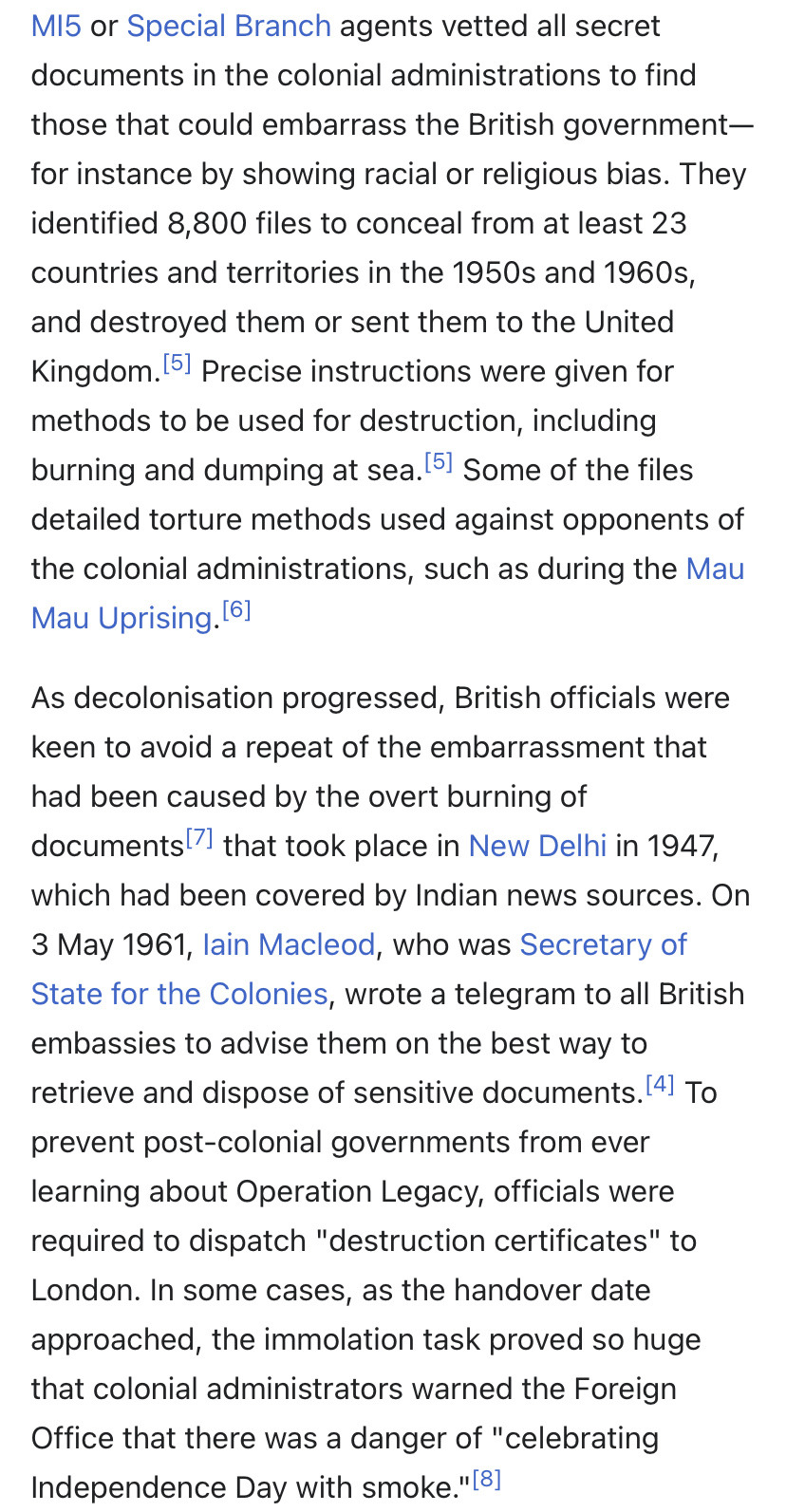Text
14 Aug 23
With the deadline for residents to weigh in on the proposed 360-degree missile defense system for Guam passing Friday, demonstrators gathered at the Chief Kepuha Park roundabout in Hagåtña for a protest for peace.
Members of activist group Prutehi Litekyan: Save Ritidan and Independent Guåhan, as well as other concerned citizens, stood along the roadside holding signs emblazoned with the slogans "No war for Guåhan," "Defend the sacred!" and "No more imperialist war games" as the evening traffic rush ramped up.[...]
Beyond raising concerns regarding the environment, natural and cultural resources, and land that the group has raised with previous military construction projects, Flores said she doesn't believe the system will bring more security for Guam.
"It's really important that we ask ourselves what genuine security means," she said. "It ... definitely means more than national security. It means having clean water, living in our homeland without the risk of war ... and we feel that the missile defense system definitely makes us a bigger target for war."
Though the system is being sold as a way to protect Guam, its purpose is to help use Guam as a base for the U.S. military to project force and protect the nation, she said.[...]
U.S. Indo-Pacific Command has called the Guam Defense System the top national defense priority for the region.
19 Aug 23
457 notes
·
View notes
Text
6 notes
·
View notes
Text
3 notes
·
View notes
Text
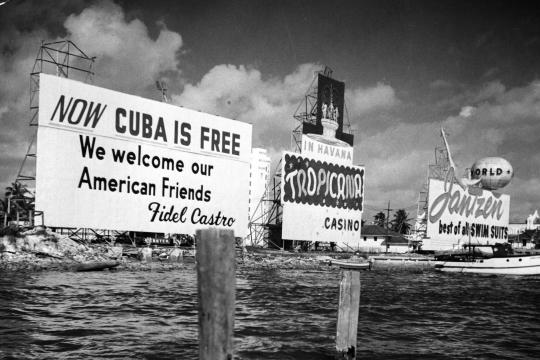
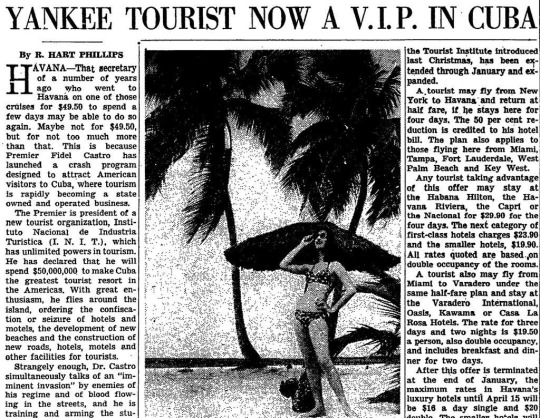
This is part of a series on American assassinations of foreign and possibly domestic leaders, and part of a miniseries on the American intervention in the Dominican Republic and Cuba during and prior to 1965. It has been held up to some extent by writer's block surrounding the use of violence and detail. I hope the salaciousness meets but does not exceed nor lag expectations. The previous part, part 7, is available here.
On the afternoon of March 4, 1960, a Belgian ship was offloading 76 tons of explosive munitions directly onto the docks at Havana. At 3:10, an explosion rocked the ship. It was big enough to damage the docks, and dozens were killed or wounded. The Cuban army organized a relief effort. Che Guevara, a trained doctor, drove down as fast as he could. Fidel Castro observed overhead in a helicopter. 30 minutes after the first explosion, a second, seemingly well-timed, hit the relief workers and damaged the helicopter. The total death toll may have been as high as 100. The American State Department in memos blamed the French, who they said were incensed by Cuban support for an independent Algeria. At a memorial the next day, Castro made it quite clear who he blamed. A photojournalist took the following pictures there, including perhaps the most famous image to ever be placed on a t-shirt:
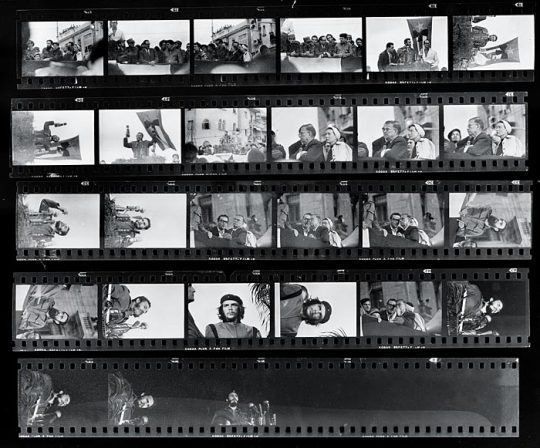
A few days later the Miami Herald, whose journalists in the employ of the CIA were known as AMCARBON-1, -2, and -3 (AM being Cuba), published an interview fingering a culprit. A man had witnessed William Alexander Morgan, an American who had fought with Castro, board the ship the day before. Morgan was both a strong believer in the Cuban Revolution and a liberal who insisted that Castro had no communist leanings. He'd actually participated in the armed suppression of a Trujillo-backed invasion months before. Dominican intelligence agents had approached him and offered $1 million, raised in part from American mafia figures, with a quarter as a down payment to facilitate the landing of former Batista soldiers and arms. Morgan pocketed the money then told the Cuban government, and the invasion force was either captured or slaughtered. Trujillo placed a bounty on his head. He walked hand-in-hand with Castro and Che during the memorial service, but by June 1960 at the latest he was known to be smuggling weapons on behalf of the CIA to rebels. He claimed he was disenchanted with Cuba's increasing closeness to the Soviet Union. Ultimately, he was arrested and executed the month before the Bay of Pigs Invasion. Adam Driver will be playing him in the biopic.
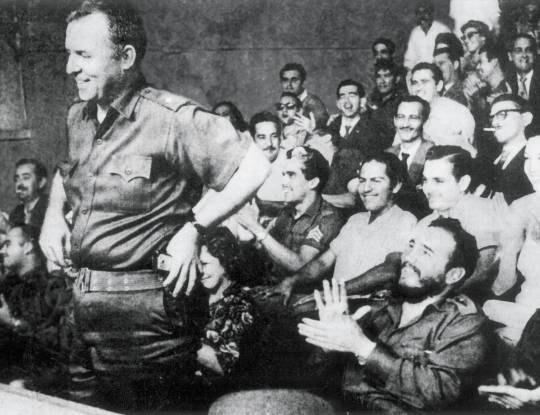
On March 17 and April 14, Eisenhower once again affirmed the plans for Castro and Trujillo, albeit with hours of discussion on the former and only minutes on the latter. American staff did "not find Cuba to be under Communist control", but nevertheless felt that Castro was "the Communist type", as "his confused doctrine of Castro-humanism will take him to a position of world prominence as a radical agitator of under-developed areas". Castro, meanwhile, was still hedging his bets, buying guns from the Czechs rather than the Soviets directly, who he did not allow to reopen their embassy in Havana. While “Trujillo is a man of great pride with great love for his country, his people and his family,” he had to go because “it appears impossible to shake the belief of Latin America that the Trujillo situation is more serious than the Castro situation. Until Trujillo is eliminated, we cannot get our Latin American friends to reach a proper level of indignation in dealing with Castro.” The plan for Cuba was to flood the country with propaganda, train dissidents in peaceful and violent protest, and build a paramilitary force for an eventual invasion. The plan for Trujillo was to "make prior arrangements with an appropriate civil military leader group in a position to and willing to take over the Dominican Government with the assurance of United States support", then take out Trujillo through bribery, pressure, or violence, as well as any others who stood in the way of that group.
One reason Eisenhower's staff did not take kindly to the attempt by Castro to play one imperialist against another was because they were intensely racist and regarded any effort by post-colonial states to manage their resources in their own interest as a sign that they were being controlled by the Soviets. A typical example was the incoming administration of Patrice Lumumba in the Congo. At the end of July, Lumumba stopped in America to visit New York and then Washington D.C. He hoped to woo prominent business leaders and then meet with the president. However, in New York, he explained against the advice of his advisors to a group of bankers that Congolese uranium would now be traded under new agreements since the old ones with the Belgians were void. The next day, an advisor to Eisenhower called an advisor to Lumumba and said "I’m sorry, tell your Prime Minister that the President prefers to go and play golf than to meet Lumumba". Like with Castro, the Americans stonewalled Lumumba, and then when he looked instead to the Soviets for aid, they decided he was an open communist. On 18 August 1960, Eisenhower met with his National Security Council and made a vague comment that he wished somebody would get rid of Lumumba. During a 20 minute break in the meeting, he authorized $10 million for the coming invasion of Cuba so long as it consisted entirely of Cuban nationals. Three days later, America cut off diplomatic relations with the Dominican Republic on the urging of President Betancourt of Venezuela, who Trujillo had openly tried to assassinate in a carbombing, and downgraded its embassy to a consulate.
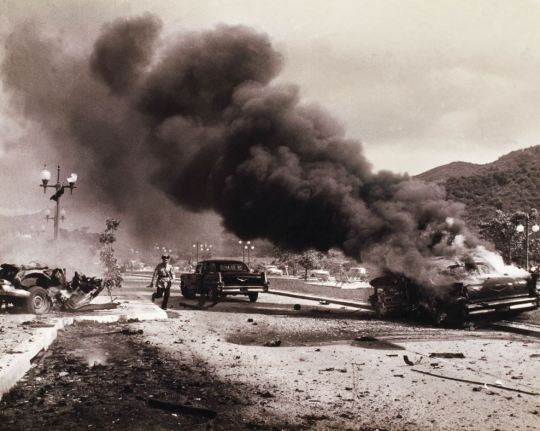
Around the same time, a CIA agent named Sheffield Edwards, known for doing odd jobs for director Allen Dulles, was meeting with a man named Robert Maheu. As a former FBI agent, Maheu had struck out on his own in 1947, doing wiretaps, burglary, and intimidation in the name of protecting a list of clients that included Howard Hughes and members of the Mafia. Maheu went through a mid-level mafia man named John Roselli to set up a meeting between two CIA agents, Sam Giancana, and Santo Trafficante, both of the Chicago mob, in late September. Together, they began to plot ways to kill Castro and get back the $100 million they'd lost in Cuban casinos to the revolution. Five- and six-figure cheques flowed freely. Poison was ordered, both to Cuba and the Congo. When it arrived in the former, a mafia man in charge of distributing it was told to keep it away from heat, so he stuck it in a freezer and rendered it useless. A plantation in Guatemala found where 500 men could be trained for an invasion, with 6 men a week ferried in teams to the mainland to build networks of anti-Castro Cubans. Reportedly, they were all were killed or captured. A few weeks later, an FBI agent in Miami told the CIA station chief there that he'd better plug up his leaks, since they'd picked up chatter among Castro's agents in the city as to a plan to kill Castro and invade from Guatemala. By November, the magazine Nation had reported what they'd learned from Guatemalan newspapers about the paramilitary training operation. By January it was in the NYT. For Trujillo, the plan was merely to send people who knew him, like his close friend and CIA agent William Pawley who'd helped overthrow Arbenz, to convince him to retire, as well as to supply small arms to rebels.
This period was largely overshadowed by the election, particularly due to JFK's shenanigans. It's unknown who let it slip to him that there was an invasion being planned, but Allen Dulles was one of the suspects. JFK's foreign policy experience in the senate had largely been to spout liberal bromides about economic development as a greater cure for communism than military might. One man he'd held a true admiration for was Patrice Lumumba. However, he was also someone who delegated rather than bringing his own ideas to the table. His dad Joe Kennedy had a meeting with Henry Luce, the CIA-linked boss of Time Magazine and namesake of Warren Hinckle's chimp, whose emissary to the agency was Charles Douglas Jackson, the mentor of Sacha Volman. Luce told Joe that any candidate he backed would have to be very tough on Castro. Joe told JFK, and his advisors came up with a wonderful idea: since his opponent Nixon couldn't mention the planned invasion of Cuba because it was covert, he should suggest that very action repeatedly and loudly, claiming that Nixon's failure to do the same was a sign he was easy on communism. It worked so well that Trujillo poured some money and manpower into JFK's campaign, which he felt would get him back into America's good books once he was elected. Part of this was because Trujillo often hung out in the same group of friends as the Kennedy family. For instance, Igor Cassini, a Russian aristocrat who fled the revolution, had become an American gossip columnist covering what he termed the "jet set", including the Kennedy family. He plead guilty in 1963 to using his influence as well as that of his brother, the designer of many of Jackie Kennedy's dresses, to try and convince JFK to back Trujillo. JFK also had an assist in the very close election campaign from the Chicago machine, an integrated network of Democratic politicians, mafia men like Giancana, and other power players in Illinois. Additionally, his token effort on civil rights, getting the son of a local preacher named Martin Luther King Senior released from prison in Georgia, won him a few votes. Ultimately, his margin in Illinois was less than 9,000. An interesting figure here is Judith Exner, a mistress of Kennedy's who was recorded visiting the White House a number of times (Bobby Baker quotes JFK in Seymour Hersh's book: "You know, I get a migraine headache if I don't get a strange piece of ass every day"). While her story repeatedly changed over the years, she claimed to have been introduced to both Kennedy and Giancana by Frank Sinatra, becoming a go-between on both the 1960 campaign and the attempts to kill Castro.
By Kennedy's election, any chance of a friendship between the American and Cuban governments had died. It was a typical tit-for-tat escalation. America threatened to withhold sugar rights if Cuba didn't return plantations owned by Americans but redistributed to Cuban peasants. Cuba then did a deal with the Soviets to sell sugar for oil. America banned its citizens at Cuban refineries from working on Soviet imports. Cuba nationalized American refineries. In October, America blocked all non-food exports to Cuba. In December, Cuba issued a statement saying they supported Soviet foreign policy wholeheartedly. That was the last straw. Castro had called in 1959 for a $30 billion American investment in Latin America to serve as a Marshall Plan for the region and was laughed out of the room by Eisenhower's flunkies. Kennedy announced a similar $20 billion investment two months after he was inaugurated specifically to counter Castro's popularity and was condemned by him as an imperialist. One month later, on April 15, the Bay of Pigs Invasion began. Kennedy had cut off Eisenhower's all-hands-on-board meetings with his diplomatic, military, and intelligence leadership because they bored him. He claimed he had not been told how bad the chances of success were despite being presented with documents stating a 30% chance of winning. To some degree, he was right. Dulles and Deputy Director for Plans Dick Bissell had systematically suppressed any reports that said Castro was popular. They were so sure the Cuban people hated the revolution that they immediately rewarded anybody they could find who said so. The result was a series of operational failures that doomed the invasion long before it started. Dulles called it the worst day of his life. Kennedy had slept peacefully through the election nailbiter but could not get a moment of rest on the night of the invasion. His most prominent demand had been for plausible deniability that America backed the attempt, yet the media had gotten the story out months prior. The result was the near death of America's Latin American priorities and national humiliation. It took weeks for Kennedy to get over it, after which he told his advisor McGeorge Bundy "Well, at least I've got three more years. Nobody can take that away from me."
At the very same time, the head of the American consular mission in the Dominican Republic, Henry Dearborn, was getting word of the plans for a new assassination attempt against Trujillo. When diplomatic relations had been broken off the previous August, both the ambassador and the CIA station chief had left the country immediately, and Dearborn filled in for both. He had already made contact with a group of conspirators believed to be sufficiently pro-American. They'd asked for small arms and funding. He was friendly to their cause, once comparing Trujillo to Dracula. As Dearborn told Charles Stuart Kennedy in an engaging interview, "I knew they were planning to do it, I knew how they were planning to do it, I knew, more or less, who was involved. Although I was always able to say that I personally did not know any of the assassins, I knew those who were pulling the strings. I knew everything except when. The only reason I didn't know when was because they didn't know either. There had to be a certain set of circumstances when they could put their plan into action." The reason for this was that the conspirators could only act when Trujillo was unguarded, which meant when he had gotten the urge to visit a favourite young mistress of his. He preferred she remain a secret and would only go to visit her at night in a 1957 blue Chevy Bel-Air with a chauffeur and no guards.
They counted among their number Antonio de la Maza, brother of Octavio who was killed in prison and used as the scapegoat for the silencing of an American citizen who had participated in the Galindez murder. Antonio and the entire de la Maza family had despised Trujillo since he came to power in 1930. The year after, he'd taken shots at an army patrol, a teenage idealist hoping to force an uprising. His father was friends with a general who put in a good word for him with the president. It was suggested that he join the army as penance. He rose to become a lieutenant, then retired to go into business. Most of the conspirators were like him. They'd spent time working for Trujillo in the military but had been poisoned by the various indignities they were forced to suffer. There were many in the country like this, who'd had a relative murdered, or a wife or daughter whose virginity Trujillo demanded as proof of their complete loyalty. General Juan Tomas Diaz had a nephew participate in an assassination plot, forcing him and his mother to seek asylum at the Brazilian embassy. Trujillo ordered him to get them out, and when he couldn't, he was forced into early retirement. General Antonio Imbert had a brother in prison for similar reasons and his career was on thin ice. They worked with a man named Severo Cabral, a longtime friend of de la Maza who was in contact with a local American grocer recruited as a deep cover CIA operative. The collective was named EMOTH, EM for the Dominican Republic.
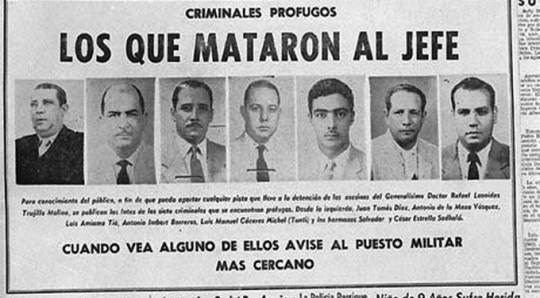
The CIA wanted them to get an actually serving army officer as a patron to ensure they could take over once the deed was done. They managed to get General Pupo Roman, the nephew-in-law of Trujillo. Pupo had run up large debts due to his incompetence running his businesses and, while indecisive, was also easily flattered. The conspirators told him he would be interim president and saviour of the country from communism, and that the CIA had endorsed (in actuality, said he was acceptable) his candidacy for the office. Moreover, Pupo's incompetence had also earned him repeated scoldings over decades from Trujillo. He'd been placed in higher positions because the leader knew he would never act on his burning desire for revenge. Now, an easy way to do so had presented itself. One last figure of importance was Amado Garcia Guerrero, a member of Trujillo's personal guard who held a "rabid hatred of the man" because he prevented him from marrying his sweetheart, the sister of an anti-Trujillo rebel. He was the one who suggested the method of assassination. Together, the men plotted at Juan Tomas Diaz' house, often after watching a Hollywood film on his 16mm projector. Seeing people killed from a moving vehicle repeatedly was one reason they ultimately went with Guerrero's plan.
They imported a Chevrolet Biscayne on credit, knowing that American cops favoured it for its no-frills interior and high speed, and upgraded an old Oldsmobile. Juan Tomas had his service weapon, a .45. Together they came up with two hunting shotguns as well as a Remington and sawed off the barrels. The CIA added three .38 Smith & Wessons and six M-1 carbines with 500 rounds, a disappointment for the assassins but easily enough to get one tortured if they were caught posessing them (codename EMDEED). They staged their drive over and over, plotting out bullet trajectories and wind speeds to determine angles of fire. They almost went on May 17, but Trujillo decided to go to a brewery instead. On the 24th, they waited again in ambush in their cars on the side of the road. Trujillo had a fever. One of the men's wife asked him on the 29th how he would escape retribution for killing the dictator. "This is a man's plan, there is no need to hide," he replied. On the evening of the 30th, Trujillo visited an air force base with Pupo. There was a leaky faucet near the front door and mud had collected outside. Trujillo had gotten his boots muddy days ago and the problem had still not been fixed. He forced Pupo to stand in it and gave him a dressing down for letting the problem fester, telling him to stay at the base until it was fixed. Just before leaving, Trujillo had informed his driver that he would be going to see his mistress a day earlier than usual and that he should be prepared for when he got back. Fortunately, Guerrero had overheard and gotten the word out.

De la Maza, Guerrero, Imbert, and one more sat in the Biscayne by an on-ramp to the Sanchez highway at the edge of the capital, in a position where they could see any car coming from a long distance away. Two others were in the Oldsmobile three kilometres away, waiting for a flash of headlights from the Biscayne to block Trujillo's car if it could not be overtaken. Two kilometres further, a third car waited with only its driver for a second chance to block. All carried at least one weapon supplied by the Americans. The chauffeur was an old comrade of Trujillo's from when he was out raping and killing peasants for the Americans, who knew to turn off the police radio because the dictator did not enjoy the chatter. As it passed the Biscayne, Imbert did a u-turn and floored it. At the 3 kilometre mark, the cars were only 150 feet apart. The Biscayne, driven by a vengeful chauvinist, did not give the signal to the Oldsmobile but instead made to pass the Bel-Air, which pulled into the slow lane to facilitate. They came side by side. De la Maza opened fire with his lever action shotgun. The first shot was true. "Cunt, I've been hit," said Trujillo. The shotgun jammed and a few seconds passed before he was hit again. The Bel-Air pulled over and the Biscayne overshot it by a few hundred feet. "Get the guns, we fight," screamed Trujillo, referring to the Thompsons and pistols in the car. The chauffeur tried to turn the car around and drive back to the capital, but Trujillo pulled open his door, and he was forced to stop it lest the man spill out. Instead, he picked up the gun from the side passenger seat and opened up on the attackers, who had jumped out of the car and lay prone on the pavement. De la Maza was impatient and in the midst of a berserker rage, hoped to make the final kill. He charged forward, shotgun at the ready. Imbert ordered the other two men with the M-1s to cover him and ran too. Trujillo crawled, hands on his personal .38, firing the odd shot in the direction of his attackers. Both Imbert and de la Maza would claim they made the final shot. It ripped through the man's body and he fell to the ground, limp. The chauffeur was hit, a bullet chipping off the top of his skull, and he fell, unconscious but not yet dead. De la Maza stood over the Trujillo and took one more shot, sending his dental bridge flying into the bushes where it would be used two hours later to confirm his death. The quadrumvirate had all at least been brushed by a bullet themselves if not hit directly. When the Oldsmobile came close, the four, thinking they were being attacked by Trujillistas, fired and hit their co-conspirator. All of them were in need of medical care and made to get it. Dazed and confused, they did nothing to cover up their act save for loading the body in their trunk to bring to Pupo as proof of the act. Juan Tomas had given his .45 to de la Maza and it lay on the sidewalk, serial number in plain view for anybody who sought to look it up. It was just after 10 pm.
It was here that the conspiracy collapsed. Three groups raced independently to find Pupo, who had already been spirited away within minutes of the killing by Trujillo's henchman Arturo Espillat. As the killing took place, Espillat was with his wife parked at the highway entrance and heard the gunshots. He got close enough to the gunfight to see the muzzle flashes, then decided he would be better served getting Pupo's help. The two of them drove past the car with Trujillo's body inside of it. The latter were in search of Juan Tomas Diaz to bring to Pupo's now empty house. Under Espillat's watchful eye, at no point did Pupo ever call for his coup d'etat. Instead, everybody acted as though Trujillo was still in charge but hiding. His family, who had tried to kill him many times themselves, refused to believe the words of Espillat and his boss, intelligence head Johnny Abbes, assuming that this was a plot to see what they would do if he died. They could have easily been overruled by a stronger authority figure. The conspirators meanwhile were quick to tell their family members and the doctors they sought out for treatment what they had done, feeling a sense of pride. Wiretapped phone calls, as all in the Dominican Republic were, ensured that the man in the Oldsmobile who'd been shot had secret police in his room within 3 hours. He quickly gave up Pupo. By 7 p.m. the next day, they had another who had given up more names and the CIA connection. By June 2, 3 of the 7 were in custody or dead while the CIA station chief was on a flight to Puerto Rico. By the 5th, two more were taken and Dearborn was out too. Juan Tomas, de la Maza, and Guerrero all went down shooting. Others were tortured. The last two, one of whom was Imbert, would never be caught. Neither would Severo Cabral.
The men who ended up in charge were Joaquin Balaguer and Ramfis Trujillo. The former had been appointed puppet president by Trujillo in one of his periods of international pressure where he could not be seen taking a direct leadership role. The latter, the dictator's son, had come back from his playboy life on his French estate with Porfiro Rubirosa the day after the assassination. He ruled simply by virtue of most others in the state apparatus listening to him despite his lack of a formal role. He finally had his cousin-in-law Pupo arrested on the 5th and subjected him to such intense tortures that he tried to commit suicide by eating a lightbulb and hitting his head on the toilet repeatedly. His death came four months later when Ramfis, torturing him while holding a loaded gun for fun, accidentally shot him. By that point, Ramfis' mental state had taken a nosedive. Dominicans began to protest, acting out when the symbol of their oppression had been removed. Johnny Abbes, who was brutal enough to repress them, was forced out to a diplomatic post in Japan for fear that he might take control. Arturo Espillat, despite being a loyal supporter, was tortured for a few days and then released to flee the country. The rest of the Trujillo family had their own little fiefdoms and resented Ramfis' increasing control. Two uncles in particular, Petan and Hector, were considered even more brutal than Rafael had been. JFK nicknamed them the "wicked uncles". They used their connections in the Popular Dominican Movement, the fake communist opposition their brother had set up to convince the Americans that there was a serious threat of the country going red, to stage riots. The American regime duly responded with 40 ships off the coast.
America was threading a tight needle. It wanted recognition in Latin America that it was a force for good after the humiliation of the Bay of Pigs which committed it to at least a "facade of democracy", in the State Department's words. At the same time, its greatest fear was another Castro, and it was far more willing to support another Trujillo, referred to by both the Americans and the Dominican opposition as the "Nicaraguan option" after the Somoza family there, than a democratic election where a left wing government won. Preference would be given to whoever could suppress the riots and keep the communists down without violating human rights too blatantly. The opposition had two elements. One was the Dominican Revolutionary Party (PRD) founded by CIA asset Juan Bosch. He had the moral support of Latin America's liberals, including the very strong government of Venezuela. The other was the nascent National Civic Union (UNC), essentially a shell for businessmen and notables opposed to Trujillo. It had some popular support because its leader was Severo Cabral, the middle man between the CIA and the conspiracy to kill Trujillo. Many other members had been close to the conspirators. In this way, the CIA defined Overton Window of the Dominican opposition.
Things were in chaos for the summer and fall. Ramfis forced out his wicked uncles only to see himself become the face of brutality, with Balaguer capitalizing. He increasingly tortured for fun and pleasure because running the country made him feel sick. By November, he'd had enough. He allowed his uncles back in for one final explosive moment. Using his connections, he staged the escape of the remaining conspirators, having a few cops killed so their bodies could be dumped by a police van supposedly carrying the prisoners. He then took the conspirators to an estate and let the extended family have a go at tormenting and shooting them. He ditched the country for Spain on his personal yacht with his father's body and hundreds of millions in savings. His uncles proclaimed themselves leaders, then woke up days later with American ships once again in harbour forcing them to step down. Balaguer thought he'd taken over, but by January 1962 he'd stepped down from his post, forced to share power with UNC and military figures, including Imbert and the 7th co-conspirator who were finally able to come out from hiding, in a council system in a desperate attempt to claim legitimacy.
The initial budget for the covert program against Cuba was $5 million, and it would ultimately grow to $50 million a year. It was named Operation Mongoose. It covered a host of actions against Cuba, mostly sabotage and bombings, but also assassinations. Bobby Kennedy was in charge since he felt personal animosity towards Castro. Unfortunately, we don't have a clear picture of it because a significant amount of the records were destroyed in 1967. Today, Cuba is still under control of the same government as under Eisenhower. Meanwhile, 6 rifles, 3 revolvers, and a few thousand dollars were enough to change the Dominican Republic and overthrow the longest ruling dictator in the history of Latin America until that point. However, it was an operation the president was far less willing to support, as Trujillo was respected in the social circles of the richest Americans and had dozens of Senators and Congressional Representatives on his side. Of course, the question of what the president was willing to support has always been a bit of a mystery, as plausible deniability has always been on the minds of those in a position to know the true history of America's system of espionage.
Dick Bissell: “If you had asked Eisenhower what he was thinking at that moment he probably would have said, ‘I sure as hell would rather get rid of Lumumba without killing him, but if that’s the only way, then it’s got to be that way’. Eisenhower was a tough man behind that smile.”
35 notes
·
View notes
Text
This is a miniseries about the 1965 American invasion of the Dominican Republic, the fifth by that nation, in the midst of a much larger series about the CIA in the 1960s and god knows what else. The above clip is from a primetime CBS news broadcast on March 13, 1967, a few weeks after the Ramparts revelations, called In the Pay of the CIA. Take note of the foundations mentioned. You can watch it here, and I would recommend doing so, because it shows which allegations the CIA was hoping to get ahead of and which ones they were hoping to bury with a counternarrative. William Small at CBS News had asked the CIA to provide a list of who at the station was in their employ, and unlike with other news organizations, the CIA refused to confirm or deny. Given the testimony of former CBS men like Sam Jaffe, foreign correspondent, as to the pushiness of the agency, it's likely that at least some were compromised. The previous part in this series, Part 6, can be read here.
In the aftermath of the Russian Revolution, the American socialist movement was deeply split. Jewish Americans tended to see the Bolsheviks as the liberators of their people still held captive by Tsarist anti-Semitism and joined the Communist Party USA. Protestants, held captive as they were by a tendency towards paternalistic politics, were horrified by the atrocities committed against Orthodox priests and of state atheism and tended towards the Socialist Party USA. Jay Lovestone, as the former, became a rising CPUSA star, working to support the party through labour union entryism in the American Federation of Labour. Politics in the party mirrored those in the Soviet Union: Lovestone supported Bukharin, James Cannon supported Trotsky, and William Foster supported Stalin. Foster and Lovestone booted Cannon from the party, then Foster booted Lovestone. Lovestone went to the Soviet Union to argue his case in front of Stalin himself, and as he tells it, he criticized the man to his face, was jailed, and had to escape. This fostered a lifelong hatred for Stalinism in his eyes, although for a number of years after he defended him opportunistically even on the outside of the Party. He brought along with him a number of loyalists, most notably Irving Brown, his best friend and muscle man (Part 3). Lovestone fell under the influence of David Dubinsky, leader of the International Ladies' Garment Workers' Union, member of SPUSA, and a vehement anti-communist. Dubinsky, the head of an all-male leadership of a 3/4 female union, prided himself on turning down wage increases when he felt they would threaten the stability of the industry, and once said "workers need capitalism like a fish needs water". He used his intelligence chief, Gus Tyler (Part 3), who had experience breaking Trotskyite groups, to suppress any local taken over by communists. He used Lovestone as his outside man, sending him to the UAW to prevent them from joining the CIO over the AFL. Victor Reuther, brother of the UAW president, described Lovestone as "one of the most Machiavellian union-splitters ever to prey on the American labor movement".

During the war, both Lovestone and Brown applied to work at the OSS. The spy agency wanted people who could provide information about the Soviet Union and communist trade unionists in Europe, who had become some of the few resisters against the Nazis. Brown was accepted, but Lovestone was felt to be too compromised. Instead, he was appointed by Dubinsky's close friend Irish Catholic George Meany, AFL treasurer and future AFL-CIO leader as well as a close CIA collaborator, to head up a new project. Meany was a schmoozer who prided himself on his conversational skills and his ability to be arrogant without seeming it, like keeping the American president waiting on the line. Lovestone was a classic intelligence man, obsessed with gleaning information and putting it to use. An underling reported that he read "twenty newspapers a day". Lovestone noted that the AFL was at the height of its power, and Dubinsky and Meany should use that to prevent the Soviets from taking over Europe. He saw that communist, socialist, and Catholic trade unions were the only ones who had survived the war, typically through extreme resistance in the case of the former and collaboration for the latter. Lovestone was appointed to create an international intelligence network to crusade against communism. By 1946, the FBI noted that Lovestone had a man in the majority of America's European embassies, largely thanks to Dubinsky's influence in the White House. The network was called the Free Trade Union Committee.
Prior to WW2, an attempt had been made at a global trade union conference. The International Federation of Trade Unions refused to take a hard line on colonialism, feminism, socialism, or any other prominent political questions of the day and so fell apart. The English Trade Union Congress attempted to create a new post-war version, the World Federation of Trade Unions, and invited Soviet and communist trade unions to participate. The AFL refused, complaining of communist subversion, but the CIO attended. Lovestone devoted hundreds of thousands of dollars, much of it from the women, largely Jewish, of the ILGWU sewing repetitively for 44 hours a week, to breaking the WFTU apart. For the AFL triumvirate, any organization that had communists was a front group. In Germany, Italy, France, and Greece, Lovestone worked hard at creating a merger between pre-war socialists and Catholics that would shut out communists who had massive sway among new membership for their part in the resistance. He used the same tactics he had at the UAW, while Brown brought his OSS experience. In large part, he succeeded because he was the only one with money in these war-torn countries. In large part, this was the same debate club tactics. People were brought together and prepared with pre-canned lines for the big debates both on the shop floor and at the general meetings. Both sides dropped phony measures with friendly, unobjectionable language to see which side independents would support. In the background, money was exchanged and positions were promised. If big wins weren't found at the conventions, plans were made for open splits with expensive press conferences and advertising. In the streets, blood had to be spilled to keep the rank and file in line and to take over a local from the outside. Money went a long way there too, as did contacts with mafia members. Wherever possible, locals that had fled to America to escape were brought in to replace the local leadership.
Ultimately, this was the same way the National Student Association got started, to torpedo an international effort feared converted by the Soviets. Like them, the AFL would soon have CIA backing to do it. The money would come from the Marshall Plan. Reconstruction was important and would require the acquiescence of labour. The point of the plan was to get people paid higher wages so they could buy more and fuel growth. American agents on the ground would distribute money to worthy projects, gaining local contacts and bettering the American brand. Countries that chose not to participate would face lower living standards. This was the perfect way for the newly formed CIA to gain intelligence on the ground. Many of the CIA's operatives were former OSS who had gone to work in the State Department and were now in charge of the Plan. Most important of these employees was Frank Wisner, who was not officially CIA but often dined with their leadership as part of the Georgetown Set, which included Ben Bradlee, Cord Meyer, and Dick Bissell. He and a more famous employee, George Kennan, writer of one of the most famous documents of the Cold War, went to work using Marshall Plan money for covert projects. These included bringing fascists from Eastern Europe to America where they could be protected, trained, and sent out to conduct guerilla warfare, and helping to sway the 1948 Italian elections with the help of anti-communist trade unions. Soon, Lovestone's FTUC was being funded with more CIA money than union money.
These men hated each other. The CIA boys were WASPs and the union men were Catholics and Jews with little in the way of formal education. They shared objectives and funding but felt that they were acting independently of each other and claimed so in their autobiographies. Thomas Braden (part 5), Lovestone's handler in the early 50s, complained of never getting any accounting books, while Lovestone derided Braden and his comrades as "fizzkids". Nevertheless, the historical record betrays a close cooperation. In a top level meeting, Wisner was described in CIA memorandum as "Mr. Lawyer", Meany as "Mr. Plumber", Dubinsky as "Mr. Garment Worker", and Lovestone as "Mr. Intellectual". They shared an odd political affiliation, a liberalism that was moderate supportive of working class demands but against any radical changes to the overall system and most definitely against the Soviet Union. They didn't just want fascists from Eastern Europe, they also wanted independent trade unionists. One of these men was Sacha Volman. In Romania, Volman had worked for the social democratic party, fighting in the resistance against the Nazis before being forced out of the country by the Soviets. Like his patrons, he was well educated and spoke many languages. They set him to work on a joint project between the AFL and the CIA, a radio station known as Radio Free Europe, translating propaganda broadcasts. Volman knew who was paying him, but like Lovestone and Brown felt like an independent, calling himself a "half-virgin".
The CIA's attention soon turned to Latin America. They brought together the remnants of the Caribbean Legion, who had contacts on the ground and in some cases had become local leaders, with Eastern European trade unionist exiles, who had backgrounds in organizing workers and could testify to the brutality of the Soviet system. Volman became personally attached to the Dominican Juan Bosch, who in exile in Figueres' Costa Rica had become attached to a training program for democratic activists sponsored by the AFL and SPUSA. Now, you may be asking yourself, why would America train people opposed to the allied regime of Trujillo? The benign explanation would be that the political attachment of American government employees to liberalism made them wish to do whatever they could to improve the character of foreign governments while working within the system. The more sinister one would be that nobody in politics trusts anyone to stay attached to them for any longer than the present moment. If your ally betrays you or even just isn't performing that the level you'd prefer, you'd better have someone you can replace him with on short notice. Better yet if the new guy has more local legitimacy than the old guy. Juan Bosch certainly did, having worked underground to organize workers as part of his banned opposition party, the Dominican Revolutionary Party (PRD).
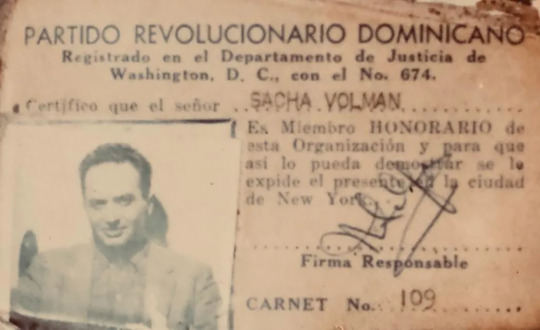
Betrayal wasn't what Trujillo was doing, but he certainly pissed off the wrong people. He knew how to pay people off to his benefit, and American politicians were no exception. One of the first men he bribed was congressman Hamilton Fish III. Fish was a progressive anti-Soviet isolationist in favour of civil rights who objected openly to the massacre of Haitians. Trujillo gave him $25,000, his standard fee, and two years later he welcomed the Dominican leader to New York with a speech proclaiming he'd created a "golden age for his country". In that case Trujillo's investment was devalued, however, by Fish' 1938 speech at a pro-Nazi conference, leading to his isolation and ultimate election loss in 1944. Others were primarily from the Senate Agricultural Committee. They held control over how much raw sugar could be imported to America for refinement, ensuring that the price remained stable and high. In turn, Trujillo owned about two thirds of the country's sugar plantations and American investors 30%. Most were staunch anti-communists, southerners, and pro-segregation. They helped determine who got foreign aid, both money and weapons, in the fight against Soviet influence in the region. Most notable of these was James Eastland, perhaps the most right wing senator in the 50s and 60s and a good personal friend of J. Edgar Hoover. Hoover was so committed to the man that when he informed Eisenhower about the bribes from Trujillo, he kept Eastland's name off the list (note: wiretapping had been ruled illegal, so Hoover simply spied on everybody in Congress and told the president the most salacious gossip so that he wouldn't object. Only Truman and JFK were uncomfortable with it). If you've seen the recent Elvis biopic, you might recognize Eastland for his bit role in the film. Of course, it wasn't just money that changed hands. The Dominican's tourism industry went from bust to boom during the 50s, and Trujillo maintained a controlling interest in all the brothels as well as many ritzy properties where members of Congress could enjoy themselves. All, of course, were bugged and had two way mirrors to expedite filming.
Despite his best efforts, in the long run these policies alienated America. Dominican dissident Jesus Galindez, a Spanish civil war vet, FBI informant, and Columbia University professor, disappeared from New York City and was never found. A man arrested in the Dominican Republic, Octavio de la Maza, was found dead in his cell with a confession that the FBI considered to be forged. Trujillo hired a high priced American PR firm that did work for the Mafia and Tammany Hall to defend the nation. Hoover got a former agent of his, Joseph Farland, appointed ambassador. Farland quickly confirmed that much of the embassy was compromised. Farland's second at the embassy even openly bragged about spending time in one of Trujillo's mansions, leading to his replacement. In 1957, members of the Chicago, Philadelphia, and Tampa Mafias, including Meyer Lansky and Santos Trafficante (large investors in Cuba, also see part 1), were flown in to discuss opening casinos on the island. The investments were minor, mostly slot machines in hotels, but led to Trujillo hiring mafia-linked men for the Galindez job as well as an attempt to kill Jose Figueres. Hoover, Eisenhower, and the brothers Dulles began prepping for an orderly transition of power. The CIA initiated funding for Juan Bosch through the charity of businessman J.M. Kaplan, owner of Welch's Grape Juice and an investor in Dominican sugar plantations, a project managed by Sacha Volman. Together, they trained 200 Latin American students in 10 week courses in politics and social change, including a heavy dose of liberal anti-communism. Some of the Kaplan money made its way to Carlos Prio, who in turn handed some of it to Castro at a meeting in 1956. Arms sales, meanwhile, were quietly suspended in early 1958 to both Trujillo and Batista, although ongoing deliveries continued and both simply bought from Nicaragua.

1959 was the key year. In the decade since the Caribbean Legion, Castro had gone from using his elected position to try and pass a law against Batista's coup to fighting in guerilla warfare. One of the men he fought with was a former OSS man named Frank Sturgis. He used his links to pick up weapons wherever he could, likely including from the CIA's Samuel Cummings, who also sold to Batista, and from Rafael Trujillo, who had wanted to bribe Batista, then tried to kill him, then begged America to resume arms sales to him. This was not strange for the lower level CIA men, who rationally assessed Castro's claims to be an liberal nationalist. Their opinions turned when the men they'd trained to staff the anti-communist secret police began to be executed. Early New Year's Day, Batista touched down in Ciudad Trujillo, the renamed capital of the Dominican Republic. "Trujillo next", Castro shouted on the day he arrived in Havana. He only intended for rhetorical support, but Che had acted quickly to set up camps to train Haitians and Dominicans in promoting revolutions. Eisenhower's advisors recommended cautious engagement to draw Castro away from Che. The president's own paranoia, not to mention Vice President Nixon's, told them otherwise. Moreover, so did the Wall Streeters who owned Cuban plantations that were now being redistributed to peasants. In March, Frank Sturgis, who'd been helping clear the gangsters from the casinos but ended up going to work for them, reached out to the FBI and let them know his own negative assessment. Castro reached out to the Soviets for aid, hoping like any small national leader to play against American intransigence in providing their's. Cuba and the Dominican Republic sent rival adventurers to overthrow each others' governments, the former backed by Romulo Betancourt, president of newly democratic Venezuela. Those in the Cuban group were armed with AR-10s that Cummings had continued selling to Castro, who had liked the feel of captured ones, after Batista had been overthrown. (Cummings was in the Dominican when it happened trying to sell more guns, and Trujillo had demanded answers, as I found out reading the CIA's files.) Eisenhower read into these actions his own worst fears. What scared him more was when Trujillo did the same thing, reaching out to the Czechs to buy arms.

In the summer, Hollywood star and socialist Ava Gardner (just saw her in the great The Killers), who'd thrown down with Rubirosa as well as JFK, decided to visit Cuba and ended up seeing Fidel. She'd wanted to bang him but was blocked by a nineteen-year-old woman named Marita Lorenz, who prevented Gardner's private notes from reaching Castro. Ultimately, the two had a physical fight that had to be broken up by a Cuban security guard. Lorenz would later float around Cuban exile circles and claimed at one point, unconvincingly, that she'd been recruited to the CIA by Sturgis and the two had met Lee Harvey Oswald to look at maps of Dallas in 1963. In an odd coincidence, Jack Ruby testified to the Warren Commission that he'd seen Gardner while in Havana on business for Santo Trafficante (Another coincidence, Juan Peron was living in exile in the Dominican Republic at the time and was quite friendly with Trujillo, but ended up getting kicked out and fled to Madrid instead where he became Gardner's neighbour). On 11 December, Dick Bissell of the CIA (his name is on the ZR/RIFLE file in part 1) put out the first written recommendation for the "elimination of Fidel Castro", although by the time this memo hit the president's desk it was toned down. On the 20th, Dick Rubottom (there's a guy who was born to be in porn) at the State Department signed off on an order to remove Trujillo from office. This was likewise written on paper to be a charm offensive to convince the man to step down. However, as we saw with ZR/RIFLE, on paper there was a burglary operation, and in real life there was something more sinister.
48 notes
·
View notes
Text
It wasn't uncommon to hear about israeli settlers attacking palestinian villages. the most brutal one in my memory being the settler that burned down a palestinian family home while the family was still inside, leaving one surviving child (the Dawabsheh family). Settlers poison palestinian wells and burn palestinian crops and olive trees and attack children coming "to close" to their settlements. I saw a video where a settler let a dog loose on children and there was a struggle to get a palestinian childs leg out of this dogs mouth. What im saying is that settlers have always been violent ppl that believe palestinians are an inferior race.
Now what's different is they r attacking everyday. Everyday they are attacking the same villages over and over (Huwara, Umm Safa, Turmusayya, Jalud, Urif, Silwan the list goes on) Committing arson on palestinian cars and businesses and homes while palestinians are still inside. They have guns. They have been shooting at palestinians from a distance. And this is not a few here and there it's literal droves of israelis coming down from their settlements and unleashing havoc.
And israeli occupation forces are helping them and letting them get away with it.
I'm gonna say this twice. This is how the israeli state was created. This is how the israeli state was created. The israeli state was created through acts of terror against a palestinian population which made the palestinians in 1948 and 1967 flee. How will these acts of terror happening daily now affect the palestinians of these villages? Do u think parents are not going to try to flee to another village?
This is not to say that palestinians haven't been fighting back. I never want to leave an image of absolute despair and helplessness. Palestinians have been able to repel these attacks and stand their ground.
This video was uploaded 21 hours ago (making this post June 25, 2023) and it shows Palestinian firefighters carrying palestinian children rescued from burning homes from Umm Safa, Ramallah.
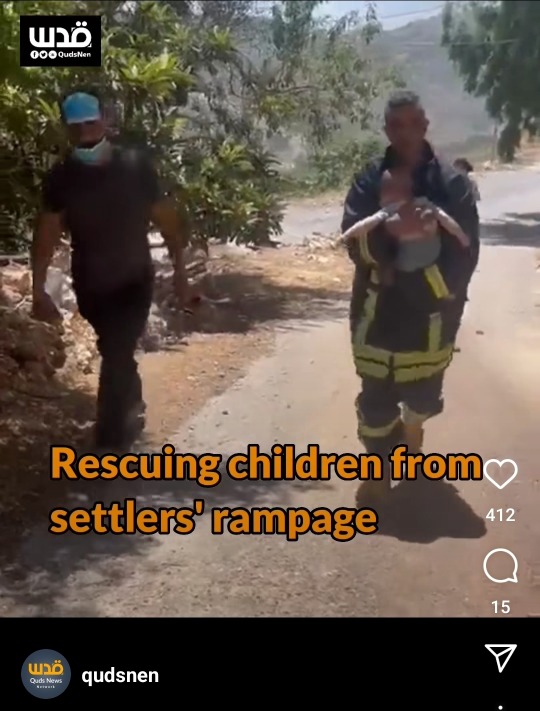

Qudsnen reported that 10 homes and 7 cars were set on fire in Umm Safa
Palestinian youth of Umm Safa are creating blockades and burning tires to keep the israeli settlers at bay


....
Tuesday night and last Wednesday (June 20/21, 2023), 400 settlers came down on Palestinian village Turmusayya and Omar Qattin (a father of two) was shot dead in midst of helping pull children out of fires.
...
Urif village, South of Nablus had an arson attack three days ago and the settlers notably video footage showed settlers invading a mosque and ripped a Quran apart. Again they have imposed this narrative that we are religious/biblical enemies.
This is going to get much worse. The israeli Minister of Security, Ben Gvir, called on the violence to continue and said, "There needs to be a full settlement here. Not just here but on all the hilltops around us. We have to settle the land of Israel and at the same time need to launch a military campaign, blow up buildings, assassinate terrorists. Not one, or two, but dozens, hundreds, or if needed, thousands."
Settlers are encouraged by this call for genocide to expand their so called state.
2K notes
·
View notes
Text
EU officials have deemed this “the worst ever tragedy” in the Mediterranean. But this shipwreck is not an aberration or an inevitable accident. It is the direct result of Greek and EU practices and regulations that have made entering Europe and seeking asylum increasingly impossible, forcing people to take more and more dangerous routes. It is the product of years of political decisions that have turned the Mediterranean into a graveyard.
…
“When you see a dead body and next to it a serial killer, you know what happened. When you see a shipwreck and next to it the Hellenic Coast Guard you should know too.” Wrote lawyer Dimitris Choulis on Twitter. He has spent years representing asylum seekers on the Aegean islands who have made the journey by boat.
In a statement, Alarm Phone similarly pointed the blame to Greece’s practices on the border: “People on the move know that thousands have been shot at, beaten, and abandoned at sea by these Greek forces. They know that encountering the Hellenic Coast Guard, the Hellenic Police or the Hellenic Border Guards often means violence and suffering,” they said. “It is due to systematic pushbacks that boats are trying to avoid Greece, navigating much longer routes, and risking lives at sea.”
3K notes
·
View notes
Text
On April 21, Ali Hussein Julood, a 21-year-old living in the Iraqi town of Rumaila, on the outskirts of one of the world’s largest oil fields, died from leukaemia. He was told by doctors that pollution from gas flared in the nearby field, which is operated by British Petroleum (BP), had likely caused his cancer. “Gas flaring” is a low-cost procedure used by oil companies to burn off the natural gas expelled during drilling. […] [I]t also contributes to global warming […]. Some of the pollutants released during this process, such as benzene, are known to cause cancers and respiratory diseases. Ali, who had been battling cancer for six years when he died, was only the latest victim of the environmental degradation caused by international oil companies like BP in Iraq.
In towns and villages near the country’s vast oil fields, thousands of other men, women and children are still living under smoke-filled skies and suffering avoidable health problems because company executives insist on putting profit before lives. […]
[A] confidential report from the Iraqi health ministry recently obtained by the BBC blamed pollution from gas flaring, among other factors, for a 20 percent rise in cancer in Basra, southern Iraq between 2015 and 2018. A second leaked document, again seen by the BBC, from the local government in Basra showed that cancer cases in the region are three times higher than figures published in the official nationwide cancer registry.
Like many other problems and crises that are devastating the lives of ordinary Iraqis today, the chain of events that led to the poisoning of southern Iraq’s skies by international oil companies also started during colonial times.
—
In the early 20th century, as its navy transitioned from coal to petrol, Britain found itself in increasing need of oil to run its empire and fuel its numerous war efforts. […] In 1912, Britain formed the Turkish Petroleum Company (TPC) with the purpose of acquiring concessions from the Ottoman Empire to explore for oil in Mesopotamia. Following World War I, it brought modern-day Iraq under its own mandate […]. By 1930, the TPC was renamed the Iraqi Petroleum Company (IPC) and was put under the control of a consortium made up of BP, Total, Shell and several other American companies. Together, they pushed for a series of “concession agreements” with the newly formed Iraqi government which would give them exclusive control of Iraq’s oil resources on pre-defined terms for long periods. By 1938, the IPC and its various subsidiaries had already secured the right to extract and export virtually all the oil in Iraq for 75 years. These concessions were granted to the IPC and its subsidiaries while Iraq was ruled by British-installed monarchs and under de facto British control. Thus the state had almost no negotiating power against the British-led consortium […] In 1955, the Iraqi government started to voice its desire to use the gas being flared in Rumaila and Zubair for electricity generation. In 1960, while negotiating a concession with the IPC, then-Iraqi Prime Minister Abd al-Karim Qasim formally asked the company to let Iraq exploit the gas that it was not using. The same demand came up again and again […], but IPC and its subsidiaries repeatedly turned the Iraqi government down. […]
Following the 2003 invasion, the Iraqi oil industry was once again privatised as a result of pressure from the US and the International Monetary Fund (IMF). As was the case in the early 20th century, any negotiations on oil extraction rights took place when Iraq was still under foreign occupation […]. When the process of auctioning off oil fields in southern Iraq began in 2008, the Iraqi government offered foreign oil companies long contracts of up to 25 years, reminiscent of the early concessions agreements with the IPC. These included stabilisation clauses, which insulated foreign companies from legal changes that might emerge over the course of their contracts. This meant that the companies were, and continue to be, unaffected by any environmental regulations passed by the Iraqi government to reduce pollution […].
—
Looking back at the development of the oil industry in southern Iraq makes apparent that the kind of pollution that killed Ali has been in the making for some 70 years. His death – like the deaths of many others who succumbed to pollution-related cancers in his country – was not an unavoidable tragedy, but the natural consequence of a long history of colonial violence and extractive capitalism.
Predatory colonial practices that began over a century ago caused southern Iraq’s vast oil reserves to be left under the sole control of foreign companies today – companies that over and over again put profit before the lives of the Iraqi inhabitants of the lands they exploit.
Ali’s death is yet more proof that colonial violence is far from over and that it has many different faces.
—
Text by: Taif Alkhudary. “Southern Iraq’s toxic skies are a colonial legacy.” Al Jazeera (English). 12 June 2023. [Some paragraph breaks/contractions added by me.]
339 notes
·
View notes
Text

It’s gonna be wild when Sweden publicly abandons its commitment to protecting vulnerable people at the request of a dictator just to join an organization that has absolutely nothing to offer them
192 notes
·
View notes
Photo
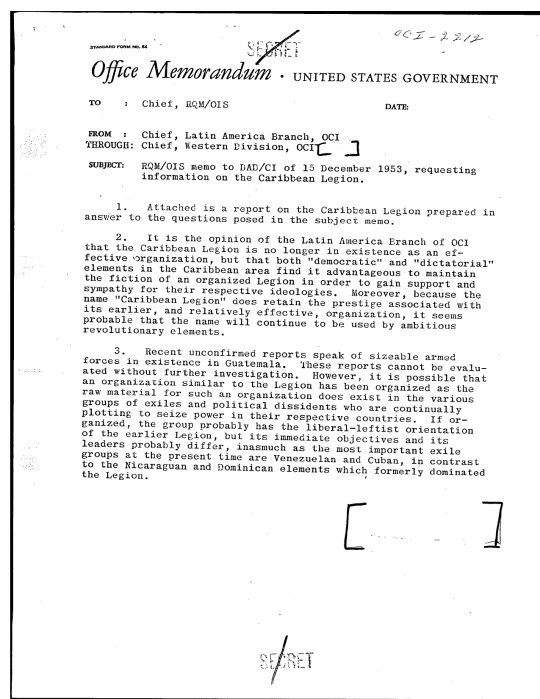
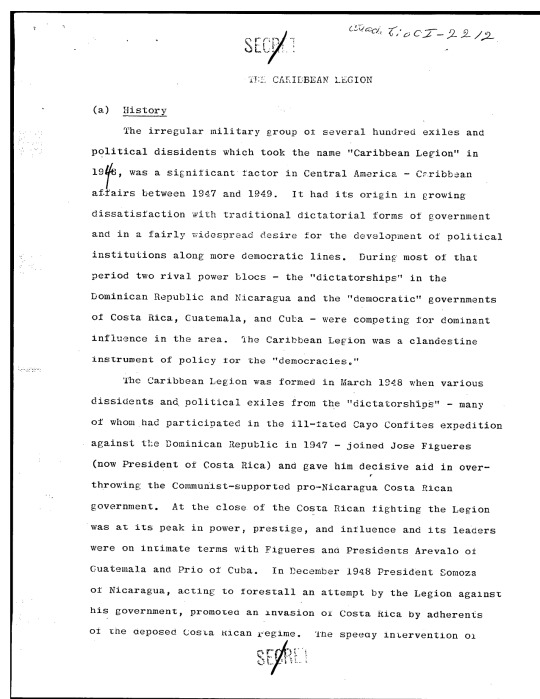

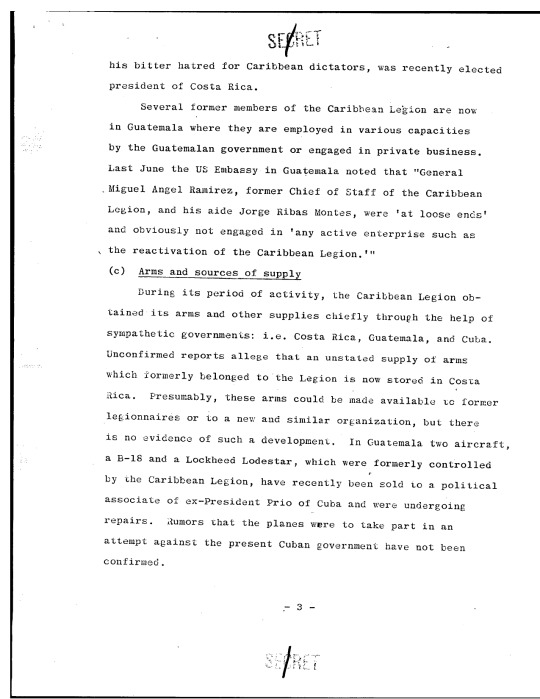

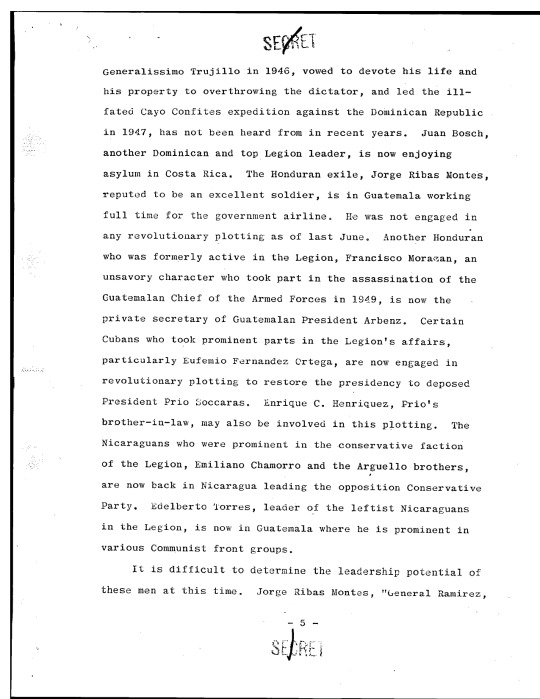


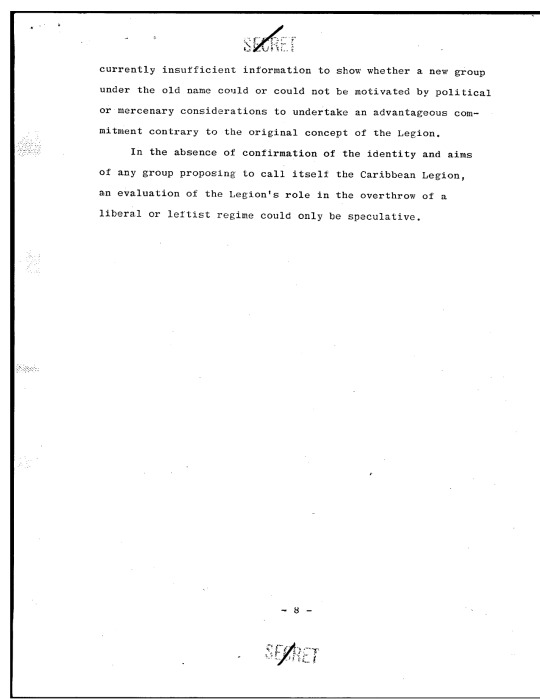
This series has repeatedly made reference to obscure events in the Dominican Republic from 1961 to 1966 which culminated in an American military invasion. They are relatively unknown and appear murky to outsiders. They united the CIA, the non-violent section of the civil rights movement, and a group of labour movement figures with links to Norman Thomas' post-Eugene Debs Socialist Party of America, the Democratic Socialist Party of today, and the Neoconservative movement that planned the Iraq War of 2003. The next two (maybe three) parts of the series will hopefully elucidate some of these events for readers. The previous part, Part 5, can be read here.
1965 was the fifth time America invaded the Dominican Republic. The fourth was in 1916, initiating an occupation that went on until 1924. America also controlled the nation's foreign trade from 1904 to 1947, collecting 50% of its revenue by heavily taxing its people on imports in order to pay off European powers with Citibank getting a commission to do the counting. These events bookended the dictatorship of Rafael Trujillo, 1930 to 1961. This resulted in a weak state unable to defend itself or the foreign corporations who wanted to invest in it.
Trujillo's government was a revolution of sorts because he directly took his methods from the mafia to govern. He'd spent years as a plantation overseer by day and gang leader by night, then joined the American-trained Dominican police and became an army officer. He learned how to use violence and manipulation to get what he wanted as well as how to pleas foreigners. In one case, he'd been sent by the occupiers to deal with a guerilla army in the interior. He was so successful that the American troops covered the reports of rapes and tortures he committed while doing so. As one of his trainers said, "He thinks just like a marine!" When the Americans withdrew, he retreated to a former castle that served as a military base, building up power until he could take advantage of a crisis and overthrow the government. Once in power, he set to creating state capacity for his rule by shaking down local industries one by one, collecting revenue and inserting loyalists into their leadership while allowing them the benefits of state backing through investment and coordination. He was so successful that he was the longest serving leader in the Caribbean's history at the time of his death.
Trujillo used a similar system of creating win-win situations to persuade American diplomats and investors to support him. He went on a charm offensive, building a tourism sector internally and using his one-time son-in-law, playboy Porfirio Rubirosa, as an ambassador and press officer. Rubirosa was not only wildly charismatic, he was also reported by Truman Capote to have an eleven inch penis. After divorcing Trujillo's daughter, he married two French actresses and the two richest women in the world back to back, making bank on his divorce settlements. Like much of the Dominican Republic's elite, he lived a charmed life, racing/crashing Ferraris and airplanes (including a B-25 bomber) internationally. Both he and his former father-in-law lived part of the year in lavish apartments in New York City, racing Ferraris and buying out brothels. Some of the money came from Dominican visas that Rubirosa sold to German Jews fleeing the Holocaust and Spaniards fleeing Franco. Trujillo had retreated there to convince the world that he had changed his ways after spearheading the massacre of tens of thousands of Haitians in his country in 1937. In the shadows he worked to mastermind a comeback, making it seem like his people organically wanted him again in the 1942 show elections. He won 100% of the vote.
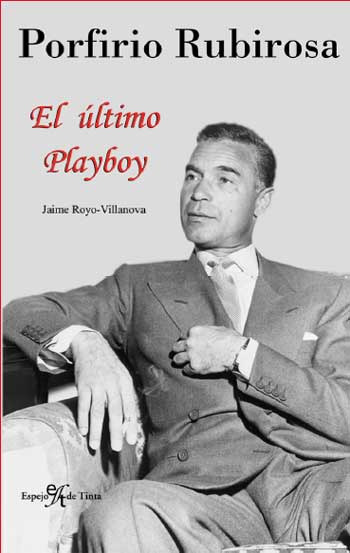
By 1947, the Cold War was on. Most people forget that this was a process initiated by a strong and muscular liberalism that had just defeated fascism and felt it could do the same to communism. Liberal intelligentsia in American government had undertaken a decade-long march through the institutions and created a new setup for the global economy with the World Bank, the International Monetary Fund, the World Trade Organization, the United Nations, and Bretton Woods. It seemed to many in the Third World that America had turned over a new leaf and was ready to support democracy abroad. For the entrenched right wing forces in Latin America, however, it seemed like business as usual. Just as he had declared war on the Nazis, Trujillo now worked to find a communist menace to kill to serve American interests. He used his agents to create a fake Marxist-Leninist party as opposition to run against him in the 1947 election. After picking up 92% of the vote, he used their supposed allegiance to Moscow to crack down on them, winning himself plaudits in Congress.
For many in Latin America, this was the last straw. In Cuba, 1200 men came together in what was termed the Caribbean Legion. Mostly exiles from Latin American dictatorships and sympathizers, they were ready to kill and die for liberalism. Some had fought in the Spanish Civil War and escaped death at the hands of the Franco regime when Trujillo had chosen to accept refugees from Europe as part of his developmental push, only to find their political allegiance was to socialism above all. They were backed by the elected leader of Cuba, Ramon Grau, who saw them as a way to topple a nearby enemy. They also pulled support from the president of Guatemala, Juan Jose Arevalo, who like his successor Jacobo Arbenz was an anti-communist liberal. Among the membership was Carlos Prio, the next president of Cuba, Juan Bosch, the most famous anti-Trujillo Dominican, Romulo Betancourt, a future president of Venezuela, Jose Figueres, the next president of Costa Rica, and a law student/basketball player at Havana University named Fidel Castro.
Figueres was a strange figure, perhaps the most fascinating of the Cold War. A plantation owner, he described himself as a "farmer-socialist". He invested his money in improving the living conditions of his workers, certain that it would make them more productive. He came to power with the help of the Legion in a very odd way, in a civil war that belongs with those pictures of Wikipedia where both sides are in odd alliances, with the right wing Nicaraguan dictatorship backing the Catholic Church and the Communist Party against Figueres' oligarch allies, supported by both America and the Guatemalan government it would later overthrow. Figueres immediately defenestrated those allies and took power for himself despite his talk of democracy, abolishing the army, nationalizing all banks, guaranteeing public education, giving citizenship to black migrants, giving women the vote, instituting social welfare, and banning the Communist Party. He helped establish the School of the Americas where the American military taught torture techniques and broke off relations with every American-backed dictator in the region. At one point, he was the subject of the only shooting war fought between different branches of the American government, when his State Department friends gave him planes to fight ones provided to Nicaragua by the CIA.

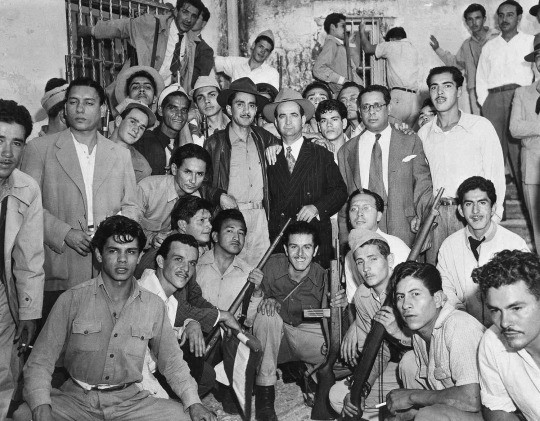
The Caribbean Legion would not have any other successes because it faced a classic problem of liberals during the Cold War: its membership was supportive of social reform, and that made the American government suspect they were secretly communists in disguise. The Legion had wanted to overthrow Trujillo, but the Americans convinced Grau to arrest them and confiscate their weapons. Castro managed to escape by jumping off the ship they were captured on and swimming to shore. Even as doors closed for the Legion, however, others opened. Ironically, it was another section of the American government that would save them. Their patron Figueres' liberal anti-communism had its fans in the CIA, which as an organization staffed largely by liberal WASPs from northeastern Ivy League universities felt that the combination would be sufficient to compete with the Soviets for hegemony among the Latin American peasantry. Figueres ended up on the CIA's payroll directly, codename HUMAIL. A lighter hand would be used for the Legion's membership, however.

26 notes
·
View notes
Photo

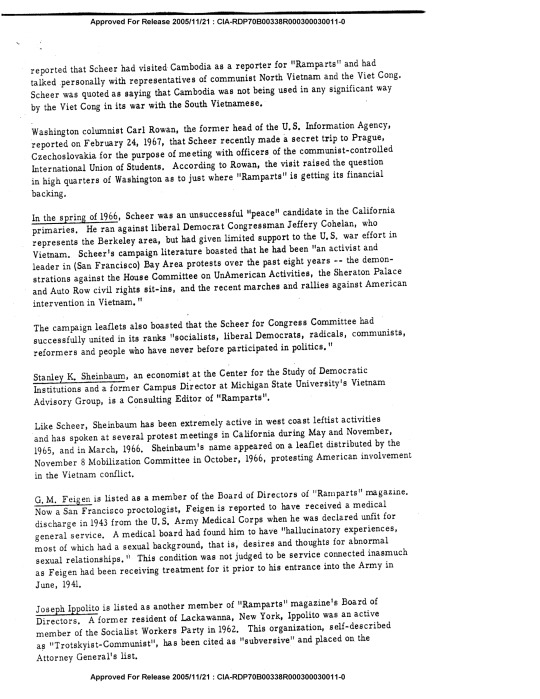
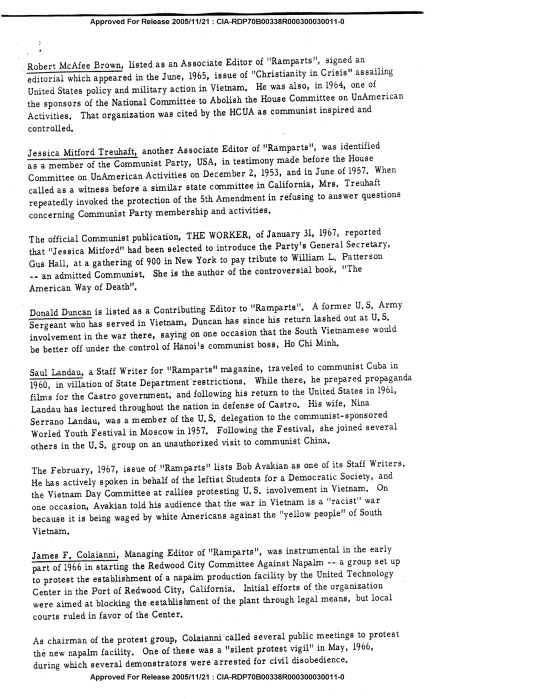

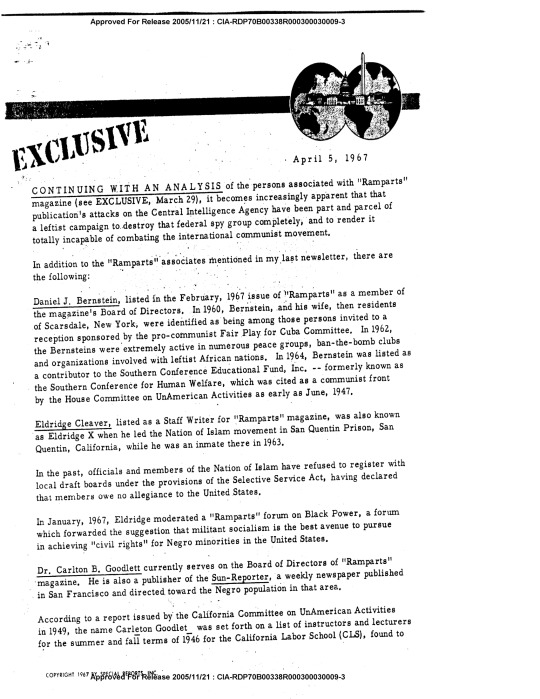

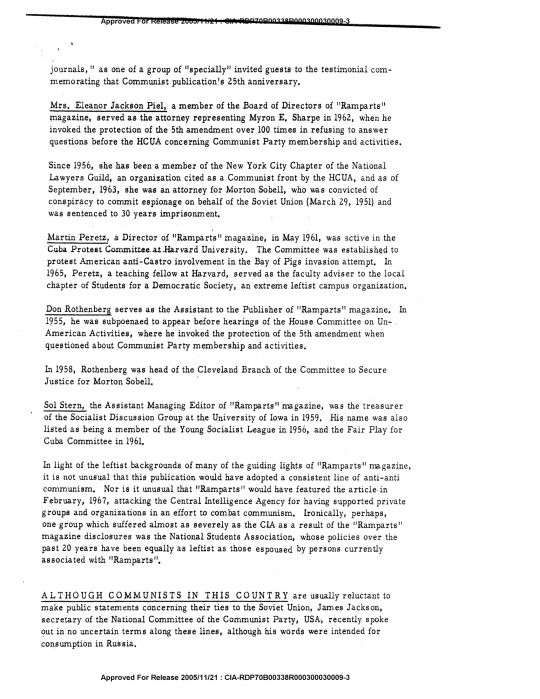

This series is shaping up to be about covert attempts by institutional power structures to undermine the health and safety of the international working class. The previous part, Part 4, is here. You can find a cool easter egg by seeing who the magazine in the bottom right image was delivered to.
The above is a dossier compiled by a right wing business intelligence group and purchased by the CIA not long after the events I’m about to share occurred. It is hosted on the CIA’s website for declassified files, the Reading Room. It was prepared by Fulton Lewis III, an outspoken supporter of the Rhodesian government and the son of a Hearst-sponsored anti-communist radio broadcaster, sort of the Tucker Carlson of the 40s and 50s. We don’t have the CIA’s own assessments because those are still classified.
When we last left the crew of the spaceship Ramparts, they were dealing with infiltration, incompetence, hedonism, an inability to secure funding, and the heady addiction of fame. Things were about to get worse as their own interpersonal disputes had come to the fore. Keating had seen his power at the magazine get whittled away as incentives in the form of shares for other backers became necessary. At the time, Hinckle counted among his friends Howard Gossage, an advertising whiz kid who helped popularize Marshall McLuhan and did the Sierra Club's first campaign. He frequently went to Gossage for advice. The two came up with a plan to push Keating into the 1966 Democratic primaries for the 11th district of California (later held by Leo Ryan, a CIA critic killed at Jonestown, and now held by Nancy Pelosi) as a way of reducing his influence on the day to day operations of Ramparts. In the midst of a meeting, they had two staff members slip away and come back with signs that said "Keating for Congress" and "Keating the people's choice".
By the start of 1966, however, the election bug had spread through the offices, both because it allowed Ramparts to make the news it reported on as salacious as possible, and because the Democratic Party had largely denied ballot access to anybody who was anti-Vietnam War. Bob Scheer, the foreign editor, ran in Oakland, and Stanley Sheinbaum, the Michigan State University professor who'd exposed the CIA's role on campus, ran in Santa Barbara. All gained 40-45% of the vote, mainly by cohering those opposed to the war. One thing in particular all three did was bring together the black vote (for instance, Julian Bond, mentioned previously in the series, campaigned for Scheer). Their campaigns were run by a coterie of Ramparts staffers, namely CPUSA member Carl Bloice as well as Berekeley lecturer Peter Collier, and were endorsed by a combination of black and Hollywood luminaries, for instance Dick Gregory, the civil rights activist and stand-up comedian, and Robert Vaughan, Napoleon Solo on the Man from Uncle and both a murderer and a victim on Columbo (see him argue about Vietnam on Firing Line with William Buckley here). Some of the opposition research on the three came directly from CIA files and was given to the establishment candidates by LBJ's press secretary Bill Moyers.
youtube
With the elections lost, Ramparts needed a new spin on things to bring back all the anti-electoral politics radicals. Fortunately, in nearby Oakland, a new group had just been founded called the Black Panther Party. Huey Newton and Bobby Seale like to portray their group as their own innovation, two upwardly mobile college kids shooting the shit late at night. The group they'd been part of prior to the BPP, the Maoist Revolutionary Action Movement, described them as "adventurists" for their desire to put theory to practice and finally organize in the community instead of just talking about it. Whatever the case, Newton learned from Robert Williams' Negroes with Guns that California law, influenced by white supremacist vigilanteism, allowed anyone to openly carry a weapon even in the presence of police. He went to Chinatown, bought copies of Mao's Little Red Book for cents, and sold them for dollars in Oakland as part of a course in organized self-defence, then used the money to buy shotguns and M-16s for use by graduates of the course. By February 1967, Ramparts staff writer Eldridge Cleaver had made contact at a speaking event for Malcolm X's widow Betty Shabazz, where the Black Panther Party founders and their cohort were the only ones armed. Cleaver invited them to the Ramparts offices for a sit down.
Remember the bit from the last part about Shabazz' bodyguards? That was Seale, Newton, and Co. Their arrival caused Hinckle's police buddies to get worried, and they put out an APB and surrounded the building, much to Newton's consternation. Hinckle suggested they go out for a drink, but nobody was buying it. Newton stared down a cop, who undid his holster. Seale put his hand on Newton, who told him off. "Don't hold my hand, brother." Seale released it, because that was his shooting hand. Newton taunted the officer. "You got an itchy trigger finger?... OK, you big, fat, racist pig, draw your gun!" All the Ramparts' staffers who'd come to watch as well as the officers' backup got the hell out of Dodge. Eventually, even the officer backed down. It was the first time the BPP had ever gotten the police to back down. It brought admiration from the entire Ramparts staff, who soon made the magazine the semi-official outlet of the BPP. And it brought Cleaver into their fold. They appointed him spokesman/Minister of Information within weeks. The following is the only news footage from that day shot after the incident, the rest having been lost, with Scheer in the background at one point:
youtube
And that wasn't even the most shocking thing going on at Ramparts. This series has previously mentioned the National Student Association as a bunch of debate nerds who essentially trained to have public speaking and organizing on their resume for future employers. The thing about the NSA was, it was a CIA front, and generally suspected as such. In 1947, there was an implosion of student politics' international facing groups. Those who had seen the Soviets fight in the Second World War generally accepted their claims to want world peace on their face, while the groups aligned with the Catholic Church teamed up with disparate right wing WASPs and Jews to fight back. The CIA had taken these students (to note, these were largely men in their late 20s or early 30s, grad rather than undergrad) under their wing and organized them into a front group that could report back on invitational events held in Eastern Europe. In turn, the top echelons of the NSA had to be sworn into legal secrecy as a prerequisite of participation, with the reward being entry into the old boys network of politicians and bureaucrats which virtually guaranteed a job.
The CIA fucked up. In 1965, the elected president of the NSA was Philip Sherburne. He was sworn into secrecy on the source of funding for their new HQ and general operations, as was normal for the group. But he disliked that they had only one source of funding, and he wanted the NSA to be independent. At the time, the grassroots in the organization who followed international politics and hewed to the left had managed to get some of their membership into power, but they had felt straitjacketed by the CIA's complete control of NSA finances. Many wanted to join in on the anti-war marches. Sherburne and others, spurred on by abrogation of Juan Bosch's regime in the Dominican Republic and the electoral fraud that brought the American-backed opposition to power, worked to find alternative sources of funding. They sent one an NSA man as part of the operation, but he got cold feet and worked with Sherburne to expose it. In response, the CIA had a number of top NSA men declared eligible for the draft in Vietnam. Bureaucratic fights ensued, involving the lives of students in America, Spain, Vietnam, and elsewhere. Finally, Sherburne went above the CIA's head to vice president Hubert Humprhey. In response, the CIA went and cut all of Sherburne's independent lines of funding. Unbenkownst to them, Sherburne had made a relatively radical student named Michael Wood his outside line to donors. He'd told Wood not to approach certain groups because they were backed by "certain government agencies". Wood had surmised that this meant the CIA and gone and picked up the only book out on the Agency: The Invisible Government, by David Wise and Thomas Ross. When he saw that the NSA's funding for 1966 had the same donor groups backed by the CIA, he realized Sherburne had lost and stole the files.
Twice the New York Times had published articles critical of the CIA in some form. In 1965, Texas congressman Wright Patman, initially elected on his support of the Bonus Army and ever a thorn in the establishment's side, had investigated 8 charitable foundations and found them to be CIA cutouts. The NYT had written an article on this as well as replies from the funded orgs (Encounter Magazine and the Congress for Cultural Freedom). In 1966, spurred by Ramparts' articles on MSU, NYT reporter Tom Wicker wrote of the allegations and added details of other botched operations around the world he'd heard from sources over the years. This brought the ire of the agency. In 1961, in response to details of the Bay of Pigs invasion being published in The Nation before it occurred, President Kennedy told his aides to bother him when details showed up in the New York Times because it otherwise did not matter. The CIA had actually worked hard to kill the very same story before the NYT could publish it so by the time the invasion failed, Kennedy apparently exclaimed that he wished more details had been published in the NYT so that the invasion would have been stopped. CIA agent Cord Meyer made the postscript of Part 3 of this series as the handler of much of the CIA's work through cutouts and allied groups like AFL-CIO, especially in in regards to the effort to influence the media known as Operation Mockingbird. Meyer and his wife, Mary Pinchot, were next door neighbours to the Kennedy's before JFK became president. Pinchot divorced Meyer after their child was killed in a car accident in 1957. She moved in with her brother-in-law, Ben Bradlee, later of Pentagon Papers and Watergate fame and played by Tom Hanks in the Steven Spielberg film The Post. In 1961, James Jesus Angleton, head of counterintelligence at the CIA, tapped her phone and discovered she was in a sexual relationship with JFK, including visits at the White House. When Pinchot was murdered in October 1964 in what was termed a robbery (a black man was arrested but acquitted), a friend of the family heard (he said) about the murder on the radio and phoned Bradlee first and Meyer second. Bradlee went to go find her diary and found Angleton sitting in her house (his garage) reading it. They later destroyed it. After that, Meyer became an alcoholic and compiled an enemies list of the CIA that included the Vice President. He was already fearful of a leak and told his subordinates to go after NSA staff but did not determine who Sherburne had told until his wiretaps of Ramparts phone lines informed him.
Ramparts, of course, knew that they had been tapped and kept phone calls brief. Scheer phoned Judith Coburn of the Village Voice and asked for her discretion. Wanting to break into a field dominated by men, Coburn felt like she was being called by a rock star, but nonetheless found it absurd that Scheer believed his calls to be tapped. She knew the CIA to be involved in assassinations like Lumumba's and thought their dealings with a minor org like the NSA were absurd. Ultimately, she helped by confronting a number of figures on their work. Eventually, a young WASP Harvard undergraduate who was on retainer from Ramparts named Michael Ansara got the call. His blog about it is excellent reading, located here. I quote:
One evening in the cold months of early 1967, my phone rang. A strange voice, obviously from New York asked, “Is this Michael Ansara?”
“Yes.”
“This is Sol Stern from Ramparts. Bob Scheer says you are our man in Boston.”
“Well . . . OK.”
“Listen I need you to do some work for us right away. I cannot tell you what it is about. I am calling you from a phone booth. Will you do it?”
“Well, what kind of work and are you willing to pay me for it?”
“It is research into two Boston based foundations. We will pay you $500.” 500 dollars was a lot of money. I had no idea how to research foundations, but I thought, what the hell. I could really use the money.
“Sure. What exactly do you want me to do?”
“I can’t tell you anything more than to find everything you can on the Sidney & Esther Rabb Foundation and Independence Foundation. They are based in Boston. I will call you in several days. You cannot call me. You cannot tell anyone what you are doing. You cannot mention the name Ramparts. Can I count on you?”
“I guess so. Sure. Yes.”
Ansara knew a much older man, an economist and lawyer who had sway in the Democratic Party named George Sommaripa. Sommaripa suggested Ansara go to a guy he knew at the IRS. Ansara did, and was told that under no circumstances could he have access to the files on two CIA cutout foundations. Chastened, Ansara complained to Sommaripa, who'd gotten the IRS clerk his job. A few days later, Ansara went back. The IRS clerk told him he could have any box he wanted, provided he did not go past the 990 form on the cover. He went past for the first two foundations and found that money came from an anonymous donor and in equal amounts went right out to the NSA. Ultimately, he pulled the files for 110 foundations, every single known group that the CIA used. He would look at the incorporation files for the foundations, see a lawyers' name, and look him up. Every time, the lawyer was an OSS operative during WW2, the predecessor org of the CIA. One of the lawyers had founded a firm with Sommaripa, a man named David Bird. Ansara confronted Bird, and Bird did not even stop to hang up on Ansara before phoning a contact at the CIA.
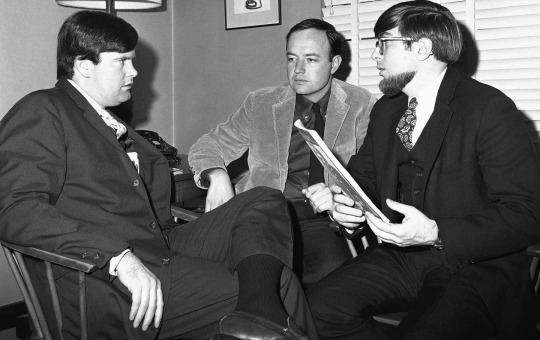
Left to right: Hinckle, Stern, Scheer.
A major corroboration of the story came from three students in New York who were disgusted by American foreign policy in Latin America. One in particular, Fred Goff, had been sent to the Dominican Republic with Allard Lowenstein (part 3) to observe the election of the pro-American candidate over the anti-American one. Goff had discovered that a man that Lowenstein had said he trusted on the country was actually a CIA agent, Sacha Volman. Another, Michael Locker, had done a paper about the CIA based on the NYT articles. Together, they walked in the doors of the AFL-CIO's American Institute for Free Labor Development and asked directly about the CIA, prompting a crashing sound and the institute's director, Thomas Kahn, planner of the 1963 March on Washington and the long-term romantic partner of Bayard Rustin, to scream at them.
The problem was when it came time to do the story. Sometimes, the researchers were paid by Ramparts. Other times, they received cheques from the Interchurch Center, a strange agency that serves as a front for charitable giving from the Episcopal, Lutheran, Presbyterian, Reformed, Methodist, and United Churches in America. James Forman, mentioned in previous parts, once led a picket in favour of reparations from them. Ramparts staff demanded they talk to them by picking up pay phones that would ring at designated times, a dismal failure. Other times, Hinckle, Scheer, and Sol Stern would fly in, book rooms at the Algonquin, and order massive amounts of takeout and booze. 15 to 20 people would be in a hotel room trying to negotiate who would be writing the story by continent, or by year, or by foundation. At one point, Coburn broke into the NSA HQ and unwittingly stole the original deed to their land, where it remained undiscovered in Ramparts' files till the 2010s.
On New Year's Eve, 1966, Lowenstein was hanging out with the new members of the NSA leadership when he informed them that Ramparts was writing about their relationship with the CIA. "The usual sloppy Ramparts piece, lots of flash, little substance," he said. The CIA had known since at least Thanksgiving. A lower level NSA official who'd just been sworn in went to meet with Hinckle and Scheer. The duo, while nonchalantly throwing darts, offered the Ramparts donor list as an incentive to tell all, but he refused. Sherburne attempted to find counsel in a lawyer who'd once opposed the CIA's new Langley HQ on NIMBY grounds. Meyer had threatened the lawyer's brother, working in Bogota with USAID, but the lawyer persisted. Undaunted, Meyer got word to Douglass Cater, the first president of the NSA and now an advisor to LBJ. LBJ bumped it to Lowenstein and the CIA to develop a response, which was to hold a press conference with an article in Henry Luce's (the man, not the monkey) Time Magazine that this was all well known since the 1965 congressional hearings, that the money was not that impressive, that the Soviets had done much more, etc.
This could have killed Ramparts. The IRS was already looking for any sign of foreign influence as an excuse to shut down the magazine. It needed some sort of relationship with the establishment press in a way that would let it gain influence without keeping it from the areas it wanted to report on. At the very same time, both Time and the NYT were reporting on the survival of Ramparts: Keating had attempted a coup and lost a board vote 13-1, with Mitford and other backers providing anonymous quotes that while they disliked the "Animal Farm-ish" nature of the issue, they needed Ramparts to stave off a fascist dictatorship in America. Hinckle followed by setting up an astounding agreement with the New York Times and Washington Post: they would get full access to Ramparts' files on the CIA right now, before the White House could set up a press conference, in exchange for letting them run full page ads for days for their next issue.
The day the Times went to press, February 13, 1963, was termed by former CIA director Richard Helms in his memoirs as "one of my darkest days". The press pushed, smelling blood. President Johnson ordered a suspension and review of CIA funding for outside orgs. The CIA initially tried to find a way to blame a dead president, Truman, but realized that its own documentation on the program, written by Cord Meyer, claimed that then-director Allen Dulles did not have any responsibility to inform the president of what he had ordered. Switching tactics, they turned on their press weapon, known as the Mighty Wurlitzer, and claimed that the CIA would have been remiss to not conduct these operations. "I'm glad the CIA is immoral" was the headline of an article by Meyer's boss, Thomas Braden. He described $250 million a year the CIA believed to be spent by the Soviet Union on cultural subversion, to which a mere handful of dollars from the CIA could not compare. No evidence for the accusations was provided, of course. Finally, Helms pulled in a favour from Robert Kennedy and had him testify to the press that his brother had authorized the funding, carried over from the days of Eisenhower. 12 former NSA presidents (including Lowenstein) came out and said the relationship was above board. All had worked for the CIA at least once after they'd left the NSA, but that was not revealed in their letter.
The strategy was a half-success. All the foundations funded by the CIA fell apart and students around the world became suspicious of CIA infiltration. Much of what Ramparts found was investigated by Congress repeatedly over the next decade, culminating in the reforms that came out of the Church Committee, which Helms claimed in his memoirs was sparked by Ramparts and Watergate. Certainly press readership was high, and many stories were published in the NYT and WaPo confirming and furthering the work done. At the same time, the CIA escaped with only a few new rules on its behaviour. President Johnson was a paranoic and was more concerned about using the CIA as a tool against his domestic enemies. He authorized a much larger role for MHCHAOS in punishing his enemies (remember the cryptonyms? MH was the most illegal, as it meant the USA). Many of those fingered were considered liberals in good standing and were part of the labour movement, particularly AFL-CIO higher-ups. They fell in line with the rhetoric about communist subversion because they knew they'd be the ones punished if things went further.
Interestingly, a few months later, the NSA held a vote on integrating an anti-Vietnam War and anti-draft stance into its platform. Traditionally, the CIA had worked from the shadows to suppress these votes. This time, Allard Lowenstein whipped in favour of the anti- stance and it won. Lowenstein soon became a fixture in the anti-LBJ movement, leading the call to bring Eugene McCarthy and Robert Kennedy into the Democratic presidential primaries. To a large extent, the organizations that were closed to the CIA had been products of decades-old relationships and worked in ways that nobody had bothered to improve. Within the CIA, a tension had always existed between bureaucrats with their own fiefdoms and up and comers with new ways of doing things. To a large extent, this scandal simply pushed the former out and made room for the latter, who would not do things like create financial records with the exact same dollar amounts going in and out, or act so bluntly when it came to manipulating staff. While the CIA may have suffered a little in the short term, it was an act of "creative destruction" that improved how the CIA did business. For Ramparts, on the other hand, things were going to get much worse now that they had drawn the ire of the intelligence community. While the magazine reached its peak distribution of 250,000 copies a month, it still did not bring in enough money to cover its expenses, and it was about to be faced with a much larger funding crisis: the Six Day War.
AFTER ALLEN DULLES RETIRED, the director bragged about the NSA operation. “We got everything we wanted. I think what we did was worth every penny. If we turned back the communists and made them milder and easier to live with, it was because we stopped them in certain areas, and the student area was one of them.”... Edward Garvey, who also worked at CIA headquarters, puts it more dramatically: “My God, did we finger people for the Shah?”... Stephen Robbins, despite his limited CIA involvement during his year as president, echoes Garvey’s concern: “It’s South Africa that keeps me up at night.”
#i am finding that i am including way too much information yet the details haunt me enough to make me put it in#i guess ramparts gets yet another part
26 notes
·
View notes
Text
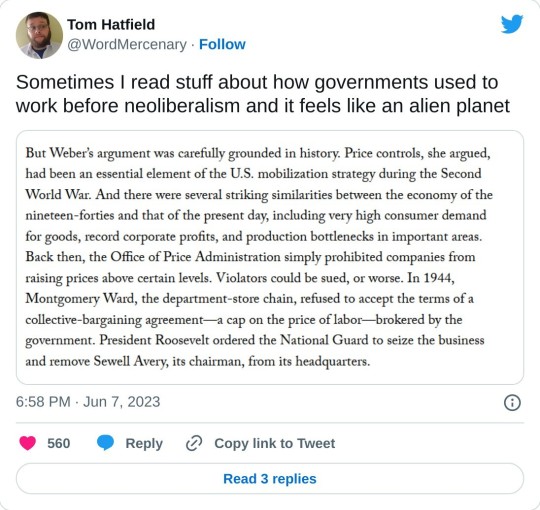
"But Weber’s argument was carefully grounded in history. Price controls, she argued, had been an essential element of the U.S. mobilization strategy during the Second World War. And there were several striking similarities between the economy of the nineteen-forties and that of the present day, including very high consumer demand for goods, record corporate profits, and production bottlenecks in important areas. Back then, the Office of Price Administration simply prohibited companies from raising prices above certain levels. Violators could be sued, or worse. In 1944, Montgomery Ward, the department-store chain, refused to accept the terms of a collective-bargaining agreement—a cap on the price of labor—brokered by the government. President Roosevelt ordered the National Guard to seize the business and remove Sewell Avery, its chairman, from its headquarters." (source)
3K notes
·
View notes
Text

Full text of thread by Stephanie Tait (@StephTaitWrites), bolded emphasis by me:
Just a reminder amid all this unbreathable air that when most states had large amounts of unspent Covid relief funds, the Biden admin told them that instead of investing in upgraded air filtration or n95s to pass out to citizens, to give it to police departments instead.
Folks out here trying to rewrite history telling you it's simply not feasible to have safe air in schools or shared buildings because "where would that much money even come from?" We literally gave states the money, and Biden told them to spend it on the police instead.
Wow. Some of y’all are up in my mentions just so SURE this is a lie made up to make Biden/the left look bad. Like even the most basic of googles will provide you a link from almost any news source you can name, from CNN to PBS to even Fox News, all saying the same thing.
Screenshot of Google result linking to NBC reading: Biden urges cities to spend Covid relief money on police, crime prevention May 13, 2022 — President Joe Biden urged states and cities to use unspent money from the $1.9 trillion Covid relief package to fund crime prevention ...
Screenshot of Google result linking to PBS that reads: WATCH: Biden urges local leaders to spend more COVID-19 money on policing May 13, 2022 — President Joe Biden gives remarks Friday on the American Rescue Plan ... “The answer is to fund the police with the resources and training ...
Screenshot of Goggle result linking to Fox News that reads: Biden urges local officials to hire more police using funds from American ... May 14, 2022 — The White House announced Friday its commitment to use $10 billion in funding from the $1.9 trillion COVID stimulus package Biden signed into
Screenshot of Google result linking to CNN that reads: Biden administration urging state and local governments to use Covid relief funding ... Jul 12, 2021 — Adams told CNN following the meeting that Biden is “sending a loud ... That includes funding for 100 new Metropolitan Police Department ...
And most states did EXACTLY as Biden directed and gave large portions of these funds to police, jails, etc. **In fact, less than 10% of the American Rescue Plan funds went to anything related to public health.** So just how much went to cops? Well…
“The majority of all current ARPA obligations, $52.6 billion, were categorized as ‘Revenue Replacement.’ […] Nearly half of this $52.6 billion went to projects that mentioned police, law enforcement, courts, jails and prisons, The Marshall Project found.” But that’s not all…
The piece goes on to explain that was just the $ that was clearly labeled as specifically going to law enforcement/jails/etc, but that much of the money wasn’t labeled for ANYTHING or was labeled for broad slush funds that most likely included law enforcement within them.
Screenshot reads: It’s challenging to parse out exactly how much money was spent solely on criminal justice nationwide, especially because the project descriptions local governments submit to the Treasury can vary in length and detail. They can be as vague as “government service expenses” ($22 million, Laredo, Texas). Or they can be as broad as “salaries and burden for the provision of core government services, which includes personnel costs for all departments” ($106.6 million, Anaheim, California). In many cases, the local government has not earmarked how they are spending the revenue replacement funds at all. In its report to the Treasury, New Orleans, Louisiana allocated all $194 million it received so far under one project: “The City has identified revenue loss replacement as its initial project.” This money, along with other revenue replacement funds, will flow to the city’s general fund, where it could be spent according to the city’s existing budgetary priorities.
The article also gives detailed info on just HOW the $ given to law enforcement was spent. They have graphics & examples throughout the piece that show specific purchases made by specific locales - things like armored vehicles, body scanners, “premium pay” & hiring bonuses, etc
Screenshot from the article that reads: Local police agencies have used ARPA funds on law enforcement equipment and capital expenses — from tasers and rifles to cars and shooting ranges. The Marshall Project found five municipalities used funding to purchase armored vehicles. At least 38 governments across the country used ARPA funds for police tasers. Nine spent ARPA funds on police drones.
A screenshot of an example from the piece that says: Josephine County, Oregon Project name: Lenco Bearcat G3 Armored Vehicle for the Sheriff’s Office Obligation: $300k
A screenshot of an example from the piece that says: State of Delaware Project name: DSP Mobile Command Unit Vehicle Obligation: $2.2M
A screenshot of an example from the piece that says: Chautauqua County, New York Project name: New Handguns Obligation: $44k
Don’t miss that last bit here, that “Colorado’s Department of Corrections allocated $1.3 million in “Private Prison Retention Bonuses” to employees who work at the private CoreCivic facility.” They spent 1.3 MILLION in PUBLIC funds on bonuses for employees of PRIVATE company.
A screenshot from the article that reads: Cities and states spent significant ARPA funds on payroll, bonuses, and hiring incentives to police and correction officers. The Los Angeles Police Department received more than $300 million from the city to cover salaries for sworn officers. Phoenix, Oregon, allocated half a million dollars to its police department for “additional [s]taffing of police due to Covid-19 and homeless population.” Greenwood County, South Carolina budgeted more than a quarter-million dollars to give detention center workers each a $10,000 bonus, and offer $10,000 sign-on bonuses to new employees. Colorado’s Department of Corrections allocated $1.3 million in “Private Prison Retention Bonuses” to employees who work at the private CoreCivic facility.
The piece ends with this tidbit where a county debated using 25 MILLION in PUBLIC funds to transfer incarcerated ppl 8 hrs away to a PRIVATE prison. County officials testified that they desperately needed those funds for other important things & none supported the plan. And yet?
Screenshot from the article which reads: In July, commissioners in Harris County, Texas debated whether to approve another $25 million from ARPA to transfer incarcerated people eight hours away to Giles Dalby Correctional Facility, a private prison run by Management and Training Corporation. “We would rather spend that money here on roads and more health initiatives and other more productive things,” County Commissioner Adrian Garcia said in a public meeting. It is inhumane to make people travel for hours to visit their loved ones, but maintaining an overcrowded jail is even more inhumane, he told his fellow commissioners. “While we can weather it for this year and use ARPA funds, that’s at the cost of not doing something else with those ARPA funds”, said County Administrator David Berry. Judge Lina Hidalgo called it “kicking the can down the road.”
“Despite the misgivings and criticism, the commission unanimously approved the spending.” Of course they did.
The piece is more than worth the read & includes way more details and examples than the ones I included here. But the TL/DR is that less than 10% of these federal Covid relief funds went to anything public health related & LOTS went to law enforcement.
And Biden not only *allowed* it, he specially told them to do it. He WANTED them to do it. In fact, he specifically pointed to using these Covid relief funds for police as a win in his State of the Union address that year, while directly criticizing the #DefundThePolice movement.
A screenshot from the same article from the Marshall Project that reads: A year later, ARPA became one of President Biden’s talking points to demonstrate Democrats are not out to defund the police. “[T]he American Rescue Plan … provided $350 billion that cities, states, and counties can use to hire more police, invest in more proven strategies like community violence interruption, trusted messengers,” Biden said during his State of the Union address this year. “We should all agree the answer is not to defund the police,” he continued. “It’s to fund the police. Fund them. Fund them. Fund them with the resources and training — resources and training they need to protect our communities.”
This is who Biden is. No, that’s not “fake news” or misinformation designed to make him look bad. He has ALWAYS been extremely pro-law enforcement. Anyone who took so much as 5 minutes to look at his voting record new that BEFORE he was elected President.
837 notes
·
View notes

